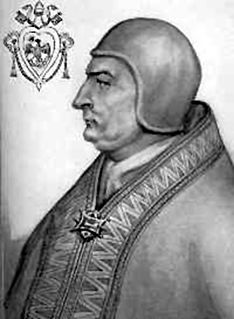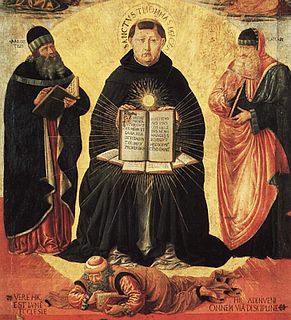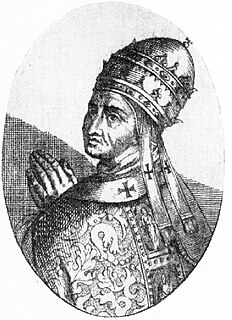This page is based on this
Wikipedia article Text is available under the
CC BY-SA 4.0 license; additional terms may apply.
Images, videos and audio are available under their respective licenses.

The Order of Preachers, also known as the Dominican Order, is a mendicant Catholic religious order founded by the Spanish priest Dominic of Caleruega in France, approved by Pope Honorius III via the Papal bull Religiosam vitam on 22 December 1216. Members of the order, who are referred to as Dominicans, generally carry the letters OP after their names, standing for Ordinis Praedicatorum, meaning of the Order of Preachers. Membership in the order includes friars, nuns, active sisters, and affiliated lay or secular Dominicans.

Pope Clement IV, born Gui Foucois and also known as Guy le Gros, was bishop of Le Puy (1257–1260), archbishop of Narbonne (1259–1261), cardinal of Sabina (1261–1265), and Pope from 5 February 1265 until his death. His election as pope occurred at a conclave held at Perugia that lasted four months while cardinals argued over whether to call in Charles of Anjou, the youngest brother of Louis IX of France, to carry on the papal war against the Hohenstaufens. Pope Clement was a patron of Thomas Aquinas and of Roger Bacon, encouraging Bacon in the writing of his Opus Majus, which included important treatises on optics and the scientific method.

Saint Dominic, also known as Dominic of Osma and Dominic of Caleruega, often called Dominic de Guzmán and Domingo Félix de Guzmán, was a Castilian priest and founder of the Dominican Order. Dominic is the patron saint of astronomers.

Santa Maria sopra Minerva is one of the major churches of the Roman Catholic Order of Preachers in Rome, Italy. The church's name derives from the fact that the first Christian church structure on the site was built directly over the ruins or foundations of a temple dedicated to the Egyptian goddess Isis, which had been erroneously ascribed to the Greco-Roman goddess Minerva.

Sutton is a residential suburb on the Northside of Dublin, Ireland. It occupies the tombolo which links Howth Head to the mainland, some of the lower slopes of Howth Hill, and a little of the adjacent coasts. The area lies within the jurisdiction of Fingal County Council. There is a small commercial core at the Sutton Cross road intersection.

The Basilica of San Sisto Vecchio is one of the over sixty minor basilicas among the churches of Rome, and a titular church since 600 AD. As such, it is connected to the title of a Cardinal priest, the current holder of which is Marian Jaworski of Ukraine.

Fara in Sabina, also spelled Fara Sabina, is a comune (municipality) in the Province of Rieti in the Italian region Lazio, located about 40 kilometres (25 mi) northeast of Rome and about 25 kilometres (16 mi) southwest of Rieti.

Montelibretti is a town and comune (municipality) in the Metropolitan City of Rome in the Italian region Lazio, located about 30 kilometres (19 mi) northeast of Rome on the slopes of Monti Sabini.

Reginald of Piperno was an Italian Dominican, theologian and companion of St. Thomas Aquinas.

Carlos Alfonso Azpiroz Costa, O.P., J.C.D. is an Argentinian friar of the Order of Preachers, better known as the Dominicans, who serves as a prelate of the Catholic Church.

Tomaso Barisini, better known as Tommaso da Modena and sometimes called Tomaso Baffini was an Italian painter of the mid-14th century.
Sisto Fabri was a theologian and canon lawyer of the Dominican Order who was appointed Master of the Sacred Palace by Pope Gregory XIII serving from 1580 to 1583, and Master of the Order of Preachers from 1583 to 1589.
Ippolito Maria Beccaria was the Master of the Order of Preachers from 1589 to 1600.

Pope Benedict XI created 2 cardinals in 2 consistories held during his pontificate. Both cardinals he appointed were Dominicans like the pope himself.














